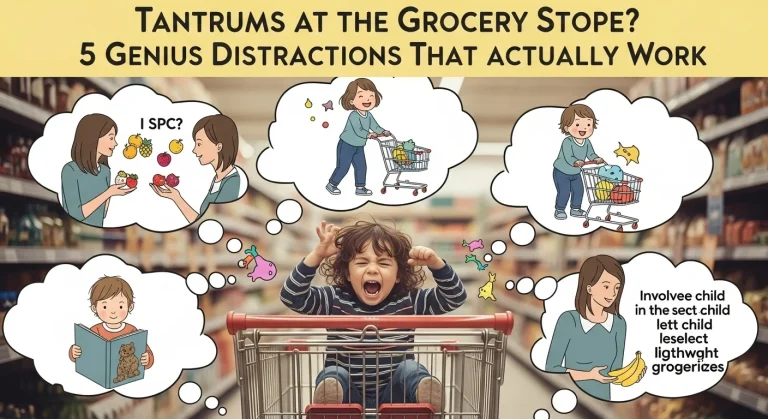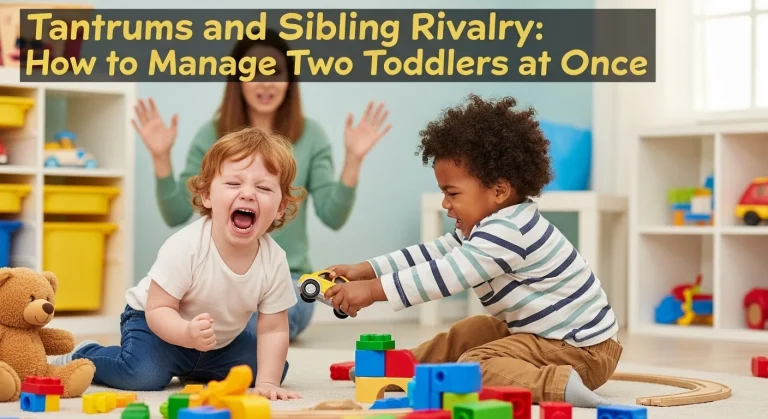Why Your Exhausted Toddler Turns Into a Volcano—and What to Do Each Day?
When your little one wakes from a nap or school day like a ticking time bomb, it’s exhausting for both of you. After countless meltdowns at our house, I discovered a more intentional approach to exhausted toddler tantrums—rooted in routines, understanding, and calm transitions. This guide covers why your toddler erupts when they’re tired and exactly what you can do each day to defuse the emotional eruption before it happens.

Part 1: Why Exhaustion Becomes a Toddler Volcano
1. Sleep Deprivation Rolls Over
Missing naps or late night sleep reduces brain control, making emotional regulation nearly impossible. As cortisol rises, tantrums follow.

2. Overstimulation All Day
Too many outings, loud noises, extra sugar, or extended play without recovery time can overload a toddler’s system.

3. Hunger + Low Blood Sugar
Even a short window without food destabilizes mood. Toddlers equate low energy with frustration, not fatigue.

4. Big Feelings + Low Thresholds
When tired, tantrum triggers are amplified: a missing toy, a closed door, “no” becomes an emotional trigger.

5. Neurological Development
Toddlers’ brains are still learning how to manage emotions. Exhaustion weakens their developing inhibition until meltdown triggers happen.
Part 2: Morning Routine Reset
✔ Calm Start
Begin with a small ritual—croissant and milk in pajamas, quiet story time—to reduce morning overstimulation.

✔ Hydration & Protein First
Before breakfast, offer a milk sippy or fruit/cheese bite to stabilize blood sugar and set a steady mood tone.

✔ Visual Activity Block
Schedule quiet play (blocks, stickers, drawing) for 20 minutes before open playtime to ease nervous system engagement.

Part 3: Midday & Nap Strategies
✔ Watch the “Sleep Window”
Log every nap. Aim for consistent timing (e.g. 1 pm nap, 1.5-hour length). Early or late naps throw toddlers’ emotional regulation off.

✔ Calm Cue Before Sleep
Dim lights, quiet music, soft touch: slow your toddler down before nap time to reduce friction.

✔ Post-Nap Transition Formula:
- Gentle wake-up (open curtains, play soft noise)
- Snack + drink (protein and water)
- Calming activity (soft music or reading)
- Then permit play
This process supports emotional reset and prevents midday meltdowns.
Part 4: Afternoon Resilience Routine
✅ Structured Snack + Activity
Provide healthy snacks and sensory toys during a window when grumpy signals usually occur. This proactively meets developmental and emotional needs.

✅ Sensory Calming Bins
Offer slime, rice bin, soft cloths, or gentle textures. These help override emotional spirals with calming inputs.

✅ Tactile Clothing Options
Soft socks, cotton pajamas, or sensory-friendly clothes can reduce irritability caused by scratchy tags or seams.

Part 5: Evening Recharge Rituals
✔ Early Dinner
Aim to feed before 5:30 p.m. to avoid fatigue-related meltdowns before nightly bath and stories.

✔ Relaxing Bath + Massage
Warm water and gentle oils quiet the mind and prepare the body for rest—especially helpful when the day has been overstimulating.
✔ Bedtime Consistency
Same time each evening with predictable wind-down cues—like brushing teeth, reading a book, and turning off lights—signals restorative rest.
Part 6: Weekly Reset Practices
🗓 Reflect Friday Review
Track daily tantrum timing. Adjust nap or sleep window to prevent recurring meltdown moments.
🧠 Weekend Recharge
Offer sensory resets (like nature walks or quiet play zones) that let toddlers rest from overstimulation in preparation for Monday.
Part 7: Handling The Volcano in the Moment
Strategies During a Melt:
- Speak softly—even military pace whispers—sends calmer signals to their emotional center.
- Offer choices: “Would you like the red cup or blue cup?” Even small options help them feel control.
- Physically join them quietly, mirror breathing: it helps regulate their nervous system.
- Skin-to-skin contact or deep-pressure squeeze (bear hug) often helps toddlers reboot more quickly.

Part 8: Nap Strategy Resource
To support smoother post-nap transitions and reduce those meltdowns, check out this helpful guide on post-nap toddler tantrums that many moms base their afternoon routines on.

Part 9: Real Mom Wins & Testimonials
“Before implementing these steps, my toddler’s tantrums were daily. Now we have less frustration and a lot more closeness.” — Aisha K.
“Tracking when she cries helps reset our sleep windows and reduced meltdowns instantly.” — Melissa T.
These quotes reflect countless parent testimonials across mom groups and forums.

Part 10: Safety & Extra Tips
- Use a toddler sleep app or visual tracker for nap data.
- Keep a meltdown toolkit: snack, fidget toy, quiet corner, music!
- If tantrums persist even with routine consistency, consider medical causes or discuss with a pediatrician—some children experience sensory processing issues or sleep disorders.

Part 11: Quick Crash-Check List (Morning to Evening)
| Time of Day | Key Strategy | Prevent Tantrum By… |
|---|---|---|
| Morning | Meal + Quiet Start | Balancing blood sugar, low stimulation |
| Mid-Morning | Quiet Play block | Avoid overstimulation early |
| Pre-Nap | Dim lights, calm | Wind down sensory system |
| Post-Nap | Snack + Soft Play | Re-stabilize sleep strike |
| Afternoon | Sensory Bin time | Emotional reset |
| Dinner | Early meal + Routine | Avoid evening burnout |
| Night | Consistent bedtime | Prepare nervous system rest |
Conclusion
Toddler tantrums fueled by exhaustion are not a reflection of poor behavior—they’re signals that their little brains and bodies need intentional care. With the routines, cues, and calming rituals above, you’ll help your child express feelings without emotional explosions.
Be patient and consistent—and remember to breathe. Your calm is their anchor.







